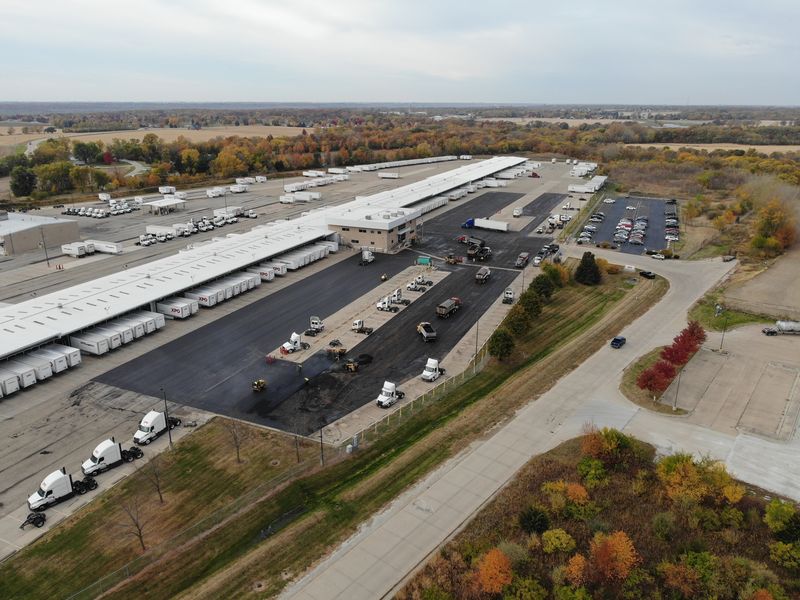Love is in the air at The Pavement Group! With Valentine’s Day quickly approaching, we can’t help but profess our love of PAVEMENT. We realize that not everyone is in love with their pavement, particularly those who have not given theirs the quality attention it needs and deserves. The result is a driving surface that is broken and in desperate need of repair. Unfortunately, emergency repairs often come with a higher price tag than the sum of annual assessments and preventative maintenance practices over time.
Loving your pavement extends far beyond an occasional sealcoat or crack filling application however; it is the cumulative choices you make every week to prolong the life of your pavement while efficiently and effectively utilizing your pavement budget. Let’s review the established strategies that will undoubtedly improve your pavement lifecycle costs.
Annual Assessments
Pavement assessments set the groundwork for every single maintenance decision you make. Assessments are imperative for providing accurate and real-time conditions of your paved surfaces. While every owner or contractor views pavement assessments differently, it’s critical to have pavement assessments done thoroughly.
A thorough pavement assessment includes images and locations of deteriorations, rating systems that identify which areas need immediate repair, and a summary of the suggested pavement maintenance techniques to complete the repairs. Contractors should also include a cost estimate for the recommended repairs.
The Pavement Group is an industry leader when it comes to providing detailed assessments for pavement owners. Our recent blog, The Importance of Pavement Assessments, highlights all the crucial components of a pavement assessment that you should not overlook as a pavement owner.
Preventative Maintenance Planning
Preventative maintenance is the key to a robust and long-lasting pavement. For that reason, it plays an integral part in improving the life cycle cost of your pavement. Preventative maintenance planning consists of utilizing your annual pavement assessments to determine where you will focus improvements. Improvements traditionally consist of sealcoating, crack filling, mill & recycling, or full-depth reclamation applications.
Having a pulse on suggested upgrades, along with a detailed analysis of the locations and work needed to make those upgrades are the keys to successful maintenance planning. While having 3-year, 5-year, and 10-year preventative maintenance plans are advised, realize that pavement deteriorates at different rates throughout the years. Therefore, allow a bit of flexibility with your planning from year to year.
Additionally, it is essential to consider improvements like fresh pavement markings and American Disability Act (ADA) compliance upgrades when reviewing your preventative maintenance needs. Failure to proactively comply with ADA requirements can lead to harsh penalties for the offending organization. Furthermore, it can create a negative impression of your business, particularly by those who navigate disabilities themselves.
DID YOU KNOW: 80% of our new customers have existing ADA violations and safety issues that previous contractors had never informed them of!
Proper Drainage & Landscaping Procedures
If you’re a pavement manager, you know just how important drainage is for your pavement’s longevity. Standing water on your paved surfaces will not only accelerate the deterioration of your pavement but can also create safety hazards for pedestrians or vehicles entering or exiting your business.
To properly drain water from your property, here are a few things to consider:
- Slope your pavement surface with artificially high and low points to entice water to run toward drains or curbing.
- Utilize storm sewers in flatter areas to allow rainwater or run-off to flow into larger grates.
- Add curbing to help redirect the flow of water.
PRO TIP: To effectively drain water from your parking lot, the asphalt slope should be between 2% and 5%.
Just as critical as managing drainage on your property is a focus on minimizing deterioration caused by landscaping efforts. Having a pulse on the potential pavement issues caused by landscaping can mean the difference between implementing anticipated maintenance updates versus costly emergency repairs. Here are the main landscaping culprits that end up wreaking havoc on our paved surfaces:
- Roots from trees and large shrubs grow under your pavement and cause buckling.
- Fertilizers that contain iron and other chemicals can cause defects in the asphalt surface.
- Water from irrigation or sprinkler systems will soften the asphalt and even erode surfaces.
Seasonal Maintenance Activities
Incorporating maintenance techniques like sweeping and removing snow and other debris from your pavement will further improve your pavement’s life cycle costs.
Sweeping includes the removal of sand, dirt, and other abrasive debris. Abrasive particles shorten the service life of your pavement, striping, and sealcoating. The typical cost of maintenance procedures to fix deteriorations caused by debris on your parking lot typically exceeds the cost of regularly scheduled sweeping.
Similarly, keeping your paved surfaces free of snow and ice helps reduce the impact of water seeping into surface cracks and forming potholes or other deteriorations throughout the freeze/thaw cycles of winter.
Conclusion
Your pavement represents one of the most significant investments you’ll encounter. It only makes sense to love your pavement by adequately assessing your paved surfaces, completing annual pavement maintenance activities, and mitigating pavement deterioration risk factors. Ultimately, establishing strategies to improve pavement lifecycle costs is the most effective way to manage your pavement.
The Pavement Group is comprised of national commercial asphalt and concrete experts. We serve all 50 states and work hand-in-hand with clients to simplify every aspect of your pavement projects from proposal to completion. Reach out to us today!


